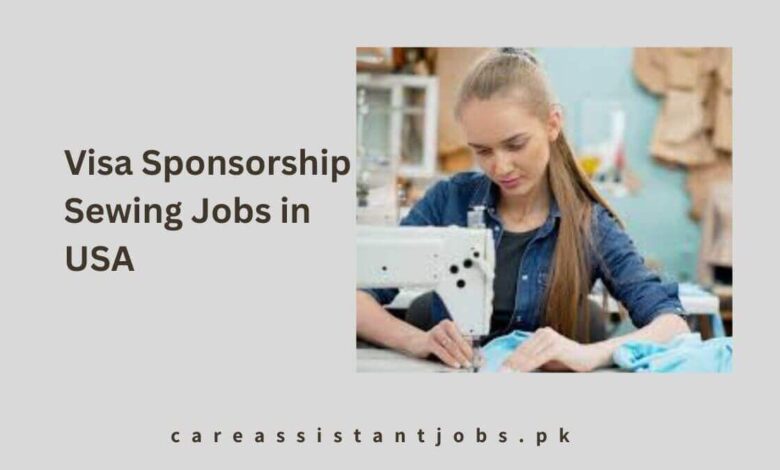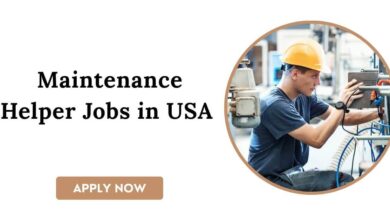Visa Sponsorship Sewing Jobs in USA 2025 – Check Here

The demand for skilled sewing laborers in the textile, apparel, and manufacturing industries of the United States is on the rise. Numerous organizations are providing visa sponsorship to international candidates to mitigate labor shortages.
Individuals who possess manual dexterity, are detail-oriented, and are in search of a stable position with potential for advancement are well-suited for sewing jobs in the United States.
Check Also: Maintenance Helper Jobs in USA – Apply Now

Job Details:
- Job Title: Sewing Professional (Various Roles)
- Location: United States (Multiple locations depending on employer)
- Visa Sponsorship: Available (H-2B, EB-3, or other relevant work visas)
Requirements:
- Educational Background: The employment of SOC 261 occasionally necessitates a high school diploma or a general equivalency diploma (GED).
- Work experience in the textile industry, fashion design, or stitching may prove advantageous.
- Technical Proficiency: The candidate must possess a comprehensive understanding of the operation of stitching machines, the cutting of materials, and the manipulation of a variety of fabrics. Additionally, it is imperative to be acquainted with measurements, patterns, and modifications.
- Attention to Detail: In sewing positions, particularly those that involve fashion designer wear or made-to-order apparel, the degree of delicacy and closeness of work are crucial.
Benefits:
Legal Work Authorization and Visa Support
Employers provide visa sponsorship, enabling foreign sewing professionals to work legally in the USA with full work authorization and stay options.
Competitive Salary and Benefits
Sewing jobs in the USA offer competitive wages that reflect skills and experience, often including health insurance, paid leave, and other employee benefits.
Skill Development and Training
These jobs provide opportunities to enhance sewing techniques, learn new production methods, and gain experience with advanced machinery and materials.
Stable Employment Opportunities
The textile and garment industry offers consistent demand for skilled sewers, contributing to stable and ongoing job prospects.
Multicultural Work Environment
Working alongside diverse teams and producing garments for various markets allows exposure to different cultures and industry trends.
Career Growth Potential
Sewers can progress into roles like quality control, production supervision, or design assistance, paving the way for long-term career advancement.
Access to Social Security and Healthcare
Visa-sponsored employees are generally eligible for social security benefits, healthcare coverage, and other essential services in the USA.
Pathway to Permanent Residency
Sewing jobs with visa sponsorship can serve as a stepping stone toward permanent residency and long-term settlement in the USA.
Duties:
- Fabric Cutting and Measuring: It is crucial to adhere to the correct cutting and measuring procedures during the production process to ensure that the final product is manufactured to the correct specifications.
- Reading and Following Patterns: To manufacture specific textiles or garments, tailors and seamstresses must possess a comprehensive understanding of pattern instructions, layouts, and any other technical drawings.
- Altering Clothing: Various sewing tasks require modifying clothing, such as hemming, resizing, or repairing garments that have sustained damage.
- Quality Control: Some of the job responsibilities include ensuring that the products are free of defects and that the seams have the appropriate number of stitches, as well as any visible loose threads.
Salary Expectations:
Sewing job remunerations in the USA depend on factors such as; location of work, experience, and the job description in place. On average, sewing professionals can expect to earn
- Entry-Level Positions: $25,000 to $35,000 annually
- Experienced sewers: This amount is typically between $35,000 and $50,000 annually.
- Specialized Positions (e.g., Pattern Makers, Tailors): The annual salary ranges from $40,000 to $60,000.
- Supervisory Positions: an annual salary of fifty to seventy thousand US dollars
Types of Jobs:
- A tailor is a professional who creates clothing for specific clients, modifies it by adding or subtracting sizes, and repairs it.
- Seamstress/Seamster: Sewers, tailors, or stitchers who sew and join clothing, accessories, or household textiles.
- Pattern Maker: Pattern makers are responsible for the creation of apparel patterns in accordance with the designer’s vision. They are also engaged in the production and preparation of garments.
- Costume Designer: Specialty costume designers, such as theatrical costume makers and tailors, are responsible for the design and stitching of costumes for stage burlesque, motion pictures, and other events.
- Upholsterer: Sewers are responsible for the fabrication and construction of furniture, transport vehicle seats, and other similar products.
- Embroidery Machine Operator: These employees employ embroidering machines to incorporate detail works, insignia, or brand logo designs into apparel and fashion fabrics.
- Garment Assembler: Garment assemblers are manufacturing laborers who are responsible for the sewing and assembly of garment components or other related accessories.
- Textile Worker: This industry employs a variety of individuals, including weavers, knitters, and spinners, as well as tailors who transform fabrics into practical items and quality controllers.
- Sewing Supervisor: Sewing supervisors are responsible for coordinating sewing sub-groups to ensure that the established production and quality objectives are met.
- Industrial Sewing Machine Operator: These professionals operate industrial sewing machines in a production environment and sew through thick fabrics, such as canvas or leather.
Job Application Process:
- Job search platforms: These platforms include social networks, job search websites, forums, employment-related boards, company websites, and traditional career sites.
- Create a Resume and Portfolio: Develop a resume that highlights your sewing experience, qualifications, abilities, and accomplishments. If it is feasible, include the portfolio of the most exceptional work completed thus far.
- Apply for Jobs Online: You may submit your resume and cover letter directly through the company’s website, currently available online employment search sites, or employment agencies that specialize in textile and sewing positions.
Frequently Asked Questions:
How much do people make sewing?
$32,500 is the 25th percentile. Salaries below this threshold are outliers. $40,500 is the 75th percentile.
Can I make a career out of sewing?
Yes, you can make money with your sewing skills. And you don’t have to be an expert sewer with years of experience to do it. Sewers, even those new to the craft, can turn their sewing skills into cash at any skill level.
How much does a sewing machine cost in USA?
Sewers, even those new to the craft, can turn their sewing skills into cash at any skill level.$150 and climb into the thousands. But how much do sewing machines cost that can fulfill most of your sewing project needs? You shouldn’t have to pay more than about $400 for a good sewing machine.



